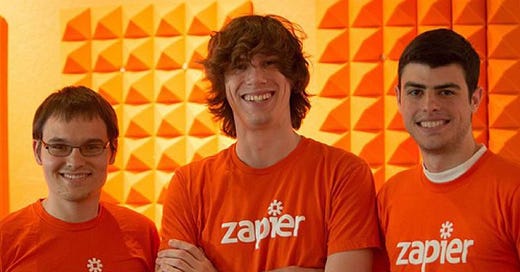The story of Zapier: Automating the Future of Work.
How zapier went from a local hackathon to being valued at $5 billion.
Zapier: Automating the Future of Work
Company Name: Zapier
Founded Date: October 2012
Founders: Wade Foster, Bryan Helmig, Mike Knoop
Headquarters: San Francisco, California
The Beginning: Turning a Problem into an Opportunity
In 2011, Wade Foster and Bryan Helmig were working as freelancers in Columbia, Missouri, building websites for local businesses. Many clients kept asking for one thing: a way to make their tools work together. Businesses wanted their apps—like PayPal, QuickBooks, and Salesforce—to share data seamlessly.
At the time, doing this required expensive developers or hours of manual work. Wade and Bryan realized they could build a solution to automate these tasks, saving businesses time and money.
Wade, Bryan, and their university friend Mike Knoop teamed up to create a tool that would allow anyone to connect apps and automate workflows without needing technical skills. This was the birth of Zapier.
The First Prototype
The team developed the first version of Zapier during a local hackathon, Startup Weekend Columbia. Over 54 hours, they created a rough prototype and won the competition. This early success gave them the confidence to keep going.
They reached out to potential users, asking, “If you could connect two apps, which ones would they be?” This feedback helped them identify the most valuable integrations to build first, like Gmail, Dropbox, and Salesforce.
The Early Days: Hustling to Get Started
With no money for a full launch, the team kept working on Zapier during nights and weekends while holding down day jobs. They personally reached out to customers, answered support tickets, and built the product, often working 12–14-hour days.
In 2012, Zapier was accepted into Y Combinator, the prestigious Silicon Valley accelerator. This was a turning point. During the program, they refined their product, gained mentorship, and raised a small seed round of $1.3 million.
Building a Remote-First Company
Zapier was born in Columbia, Missouri, far from Silicon Valley. With no access to a large pool of local tech talent, the founders decided to hire remotely from the start. This was unusual at the time but allowed them to attract the best talent worldwide while keeping costs low.
The remote-first culture became a cornerstone of Zapier’s success, long before remote work became mainstream.
Growth and Milestones
Zapier officially launched in October 2012, offering users the ability to create "Zaps"—automated workflows between apps. The response was overwhelmingly positive, and the company began to grow steadily.
Key milestones include:
2014: Zapier became profitable, a rarity for startups this early in their journey.
2017: The company reached $35 million in annual revenue and expanded its app integrations to over 1,000.
2018: Zapier crossed 100,000 paying customers, becoming the go-to platform for automation.
2021: Zapier was valued at $5 billion, solidifying its place as one of the most successful bootstrapped companies.
Today, Zapier supports over 5,000 app integrations and helps millions of users save time and streamline their workflows.
Lessons from Zapier’s Journey
Solve a Real Problem: Zapier was built to address a universal pain point—manual, repetitive tasks—and focused on doing that one thing well.
Bootstrap for Independence: By prioritizing profitability over rapid scaling, Zapier avoided the pressures of venture capital and retained control of its vision.
Listen to Your Customers: The founders' early outreach shaped Zapier’s direction, ensuring it met real-world needs.
Remote Work is a Superpower: Zapier’s remote-first culture allowed it to access talent globally and operate efficiently.
What We Can Learn from Zapier
Start Small but Think Big: Zapier started as a simple prototype at a hackathon but grew into a billion-dollar business.
Solve Everyday Problems: Great businesses don’t need to be flashy; they just need to solve real issues.
Leverage Remote Work: You don’t need to be in Lagos, Silicon Valley, Mumbai or any big city to build something impactful.
Zapier’s journey proves that persistence, customer focus, and a willingness to solve problems can lead to incredible success—even from humble beginnings in a small town.
To Ship Products or packages to your customers locally or internationally use YD package delivery service
Before you go please check our WhatsApp channel and subscribe here





